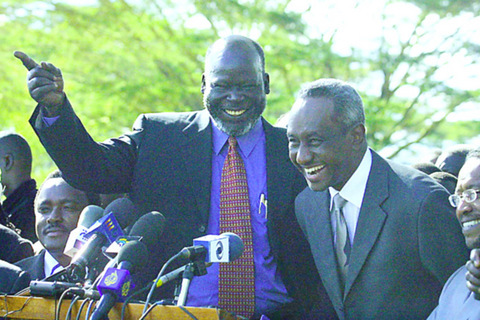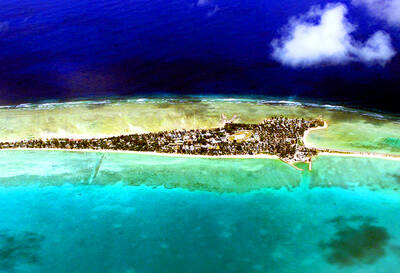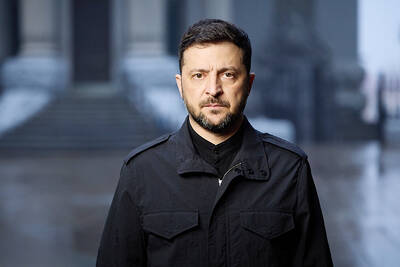Sudan's main rebel leader John Garang, who will sign a peace deal with President Omar el-Beshir tomorrow, ending more than two decades of civil war in south Sudan, once shifted his allegiances over the Cold War and its aftermath to win his people a vote on independence.
Now, he is set to become Sudan's senior vice president after the country's parliament enacts a transitional constitution -- based on the peace agreement -- by Feb. 20.

PHOTO: AFP
With the full blessing of Washington, the balding US-educated economist-turned-guerrilla once derided as a Soviet stooge, has finally won respectability as the leader of an internationally endorsed autonomous administration.
But as he swaps his military fatigues for civilian clothes, he faces the daunting task of rebuilding one of Africa's least developed regions after the continent's longest-running conflict.
Born in the remote Bor district in 1945, near the River Nile, Garang was one of the few in British-controlled southern Sudan to enjoy education beyond primary level.
After completing his secondary education in Tanzania, he went on to study economics at Grinnell College, Iowa.
In 1970, he walked away from the offer of a graduate fellowship at the University of California, Berkeley, to take up arms against the Khartoum regime.
The so-called Anyanya uprising ended with a 1972 Addis Ababa peace agreement under which Garang joined the Sudanese military, eventually rising to the rank of colonel and receiving training at the US army infantry school in Fort Benning, Georgia.
He returned to the bush in September 1983 after then president Gaafar Mohammed Nimeiri imposed Islamic law in defiance of the 1972 truce. Ironically, Garang had been sent by the government to suppress a mutiny by southern troops in his home district of Bor.
The 105 Battalion of the Sudanese army, which he had commanded in the 1970s, became the nucleus of the rebel Sudan People's Liberation Army (SPLA).
Washington's Cold War alliance with the Khartoum government prompted Garang to throw in his lot with the pro-Soviet government in neighboring Ethiopia.
He was later to dismiss the alliance as a "marriage of convenience."
The overthrow of the Soviet-backed regime in Addis Ababa in 1991 prompted a disastrous split in rebel ranks which brought Garang to his lowest ebb.
The SPLA divided on ethnic lines with Garang maintaining the support of his Dinka tribe, while the rival Nuer sided with breakaway leader Riek Machar.
The subsequent internecine fighting between the two sides appalled even sympathizers of the southern cause.
A 1994 report by New York-based Human Rights Watch accused all sides of gross violations of the rules of war, while aid agencies accused rebel and army commanders alike of diverting desperately needed relief supplies.
In the early 1990s, the regime gave refuge to Osama bin Laden, a decision that prompted a US missile strike on the Sudanese capital in 1998.
The election in 2000 of US President George W. Bush, whose Republican Party included many Evangelical sympathizers with the Christian cause in south Sudan, provided a further boost.
Through the long negotiations that followed a framework agreement in July 2002, it was Washington that maintained the momentum propelling the two sides forward.
Now that the war is finally over, Garang makes no secret of how much remains to be done to win the peace.
"We haven't had tarmac roads since creation. We are literally starting from scratch," Garang said earlier this year in his interim capital of Rumbek.

DISASTER: The Bangladesh Meteorological Department recorded a magnitude 5.7 and tremors reached as far as Kolkata, India, more than 300km away from the epicenter A powerful earthquake struck Bangladesh yesterday outside the crowded capital, Dhaka, killing at least five people and injuring about a hundred, the government said. The magnitude 5.5 quake struck at 10:38am near Narsingdi, Bangladesh, about 33km from Dhaka, the US Geological Survey (USGS) said. The earthquake sparked fear and chaos with many in the Muslim-majority nation of 170 million people at home on their day off. AFP reporters in Dhaka said they saw people weeping in the streets while others appeared shocked. Bangladesh Interim Leader Muhammad Yunus expressed his “deep shock and sorrow over the news of casualties in various districts.” At least five people,

It is one of the world’s most famous unsolved codes whose answer could sell for a fortune — but two US friends say they have already found the secret hidden by Kryptos. The S-shaped copper sculpture has baffled cryptography enthusiasts since its 1990 installation on the grounds of the CIA headquarters in Virginia, with three of its four messages deciphered so far. Yet K4, the final passage, has kept codebreakers scratching their heads. Sculptor Jim Sanborn, 80, has been so overwhelmed by guesses that he started charging US$50 for each response. Sanborn in August announced he would auction the 97-character solution to K4

SHOW OF FORCE: The US has held nine multilateral drills near Guam in the past four months, which Australia said was important to deter coercion in the region Five Chinese research vessels, including ships used for space and missile tracking and underwater mapping, were active in the northwest Pacific last month, as the US stepped up military exercises, data compiled by a Guam-based group shows. Rapid militarization in the northern Pacific gets insufficient attention, the Pacific Center for Island Security said, adding that it makes island populations a potential target in any great-power conflict. “If you look at the number of US and bilateral and multilateral exercises, there is a lot of activity,” Leland Bettis, the director of the group that seeks to flag regional security risks, said in an

‘DIGNITY’: The Ukrainian president said that ‘we did not not betray Ukraine then, we will not do so now,’ amid US pressure to give significant concessions to Russia Ukrainian President Volodymyr Zelenskiy on Friday pushed back against a US plan to end the war in Ukraine, while Russian President Vladimir Putin welcomed the proposal that includes many of his hardline demands. With US President Donald Trump giving Ukraine less than a week to sign, Zelenskiy pledged to work to ensure any deal would not “betray” Ukraine’s interests, while acknowledging he risked losing Washington as an ally. Putin said the blueprint could “lay the foundation” for a final peace settlement, but threatened more land seizures if Ukraine walked away from negotiations. Ukraine faces one of the most challenging moments in its history,